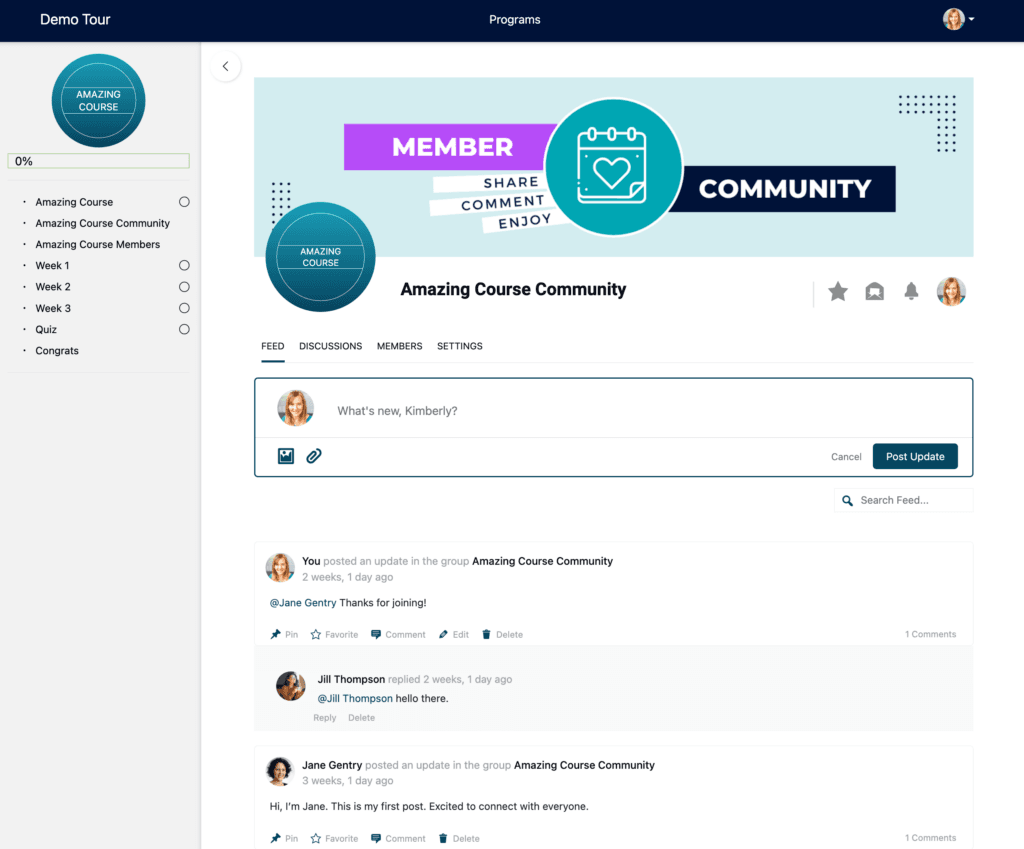Introduction and Overview: Building a Thriving Course Community
Creating an online course is just the beginning of your educational journey. The real magic happens when you transform your digital classroom into a vibrant, engaged community where students actively participate, support each other, and achieve remarkable results. Building relationships between course participants isn’t just a nice-to-have feature – it’s becoming essential for course completion rates and long-term student success.
When it comes to online education, isolation can be your biggest enemy. Students who feel connected to their peers are more likely to complete your course, implement what they’ve learned, and become vocal advocates for your program. Think of your course community as a living ecosystem that needs careful nurturing to flourish. This means creating opportunities for meaningful interactions, facilitating discussions, and establishing clear community guidelines that promote positive engagement.
The foundation of a successful course community lies in understanding your students’ needs and motivations. Are they seeking professional development, personal growth, or specific skill acquisition? This knowledge helps you design community activities that resonate with their goals. For instance, if you’re teaching digital marketing, you might create peer review sessions where students can share their campaign strategies and receive constructive feedback.
Your role as a community builder extends beyond content creation. You’ll need to wear multiple hats – facilitator, moderator, cheerleader, and sometimes mediator. The key to success is finding the right balance between providing structure and allowing organic interactions to develop. This might mean scheduling regular live Q&A sessions while also maintaining spaces for spontaneous student discussions.
Remember that community building is an iterative process. What works for one group might not work for another, so stay flexible and responsive to your members’ feedback. Start with core engagement strategies like welcome rituals for new members, structured discussion prompts, and celebration of student wins. Then, adapt and refine these approaches based on how your community responds. The most successful course communities often evolve through careful observation and continuous improvement of these fundamental building blocks.
Foundation Concepts and Planning
When it comes to building a thriving online course community, your foundation determines everything that follows. Start by defining your community’s core purpose beyond just course completion. Are you creating a space for peer support, professional networking, or collaborative learning? Your answer shapes every subsequent decision about structure and engagement.
The first critical step is understanding your course participants’ needs and motivations. Survey your existing students or ideal audience about their preferred communication styles, available time for engagement, and the type of support they’re seeking. This insight helps you design community spaces that truly serve your members rather than creating features they won’t use.
| Feature | Benefit | Use Case |
|---|---|---|
| Drip Content | Increases engagement | Course progression control |
| Quiz & Assessments | Validates learning | Student progress tracking |
| Certificates | Motivates completion | Professional development |
| Community Access | Builds loyalty | Student interaction |
Consider your community’s rhythm and flow carefully. Will you have daily check-ins, weekly accountability threads, or monthly live sessions? Your community calendar should align with your course structure while providing enough flexibility for organic interactions. Remember that different learners engage differently – some prefer quick daily touchpoints while others thrive with deeper weekly discussions.


Your technology stack matters more than you might think. Choose platforms that support your community goals while remaining user-friendly. If your course focuses on visual learning, ensure your community space can easily handle image sharing and video discussions. For writing-focused courses, prioritize platforms with robust discussion threading and document sharing capabilities.
The key to success lies in creating clear community guidelines that foster psychological safety. Develop specific policies around participation, feedback sharing, and conflict resolution. Document these expectations in a community charter that new members can easily reference. This framework helps maintain a positive learning environment while reducing your moderation workload.
Consider implementing a structured onboarding process for new community members. Create welcome sequences that introduce key community features, connect newcomers with existing members, and prompt early engagement. You might assign “welcome buddies” or create small orientation groups to help new participants feel immediately connected.
Plan your content strategy to maintain consistent engagement. Beyond course materials, prepare discussion prompts, expert interviews, and collaborative activities that align with your learning objectives. Create content buckets for different types of interactions – educational, social, and support-focused – to maintain a balanced community experience.
Finally, establish your success metrics early. Define what community health looks like for your specific context. Track not just participation numbers but also meaningful engagement indicators like peer-to-peer support instances, resource sharing, and progress toward learning goals. These metrics will guide your ongoing community development efforts and help you adjust strategies as needed.
Step-by-Step Implementation Guide
Let’s dive into creating a thriving community for your online course that keeps students engaged and coming back for more. The key to success lies in implementing a structured approach that builds momentum from day one while maintaining sustainable growth over time.
Start by creating a compelling welcome sequence that automatically triggers when new members join. This should include a personal introduction video, clear navigation instructions, and an invitation to introduce themselves in your community space. Make it easy for them to take that first step – consider providing a simple template for introductions that includes prompts like their goals, background, and what excited them about joining the course.
Next, establish your community’s rhythm with consistent content themes and engagement opportunities. Schedule weekly live Q&A sessions at the same time each week, creating predictability that members can plan around. Complement these sessions with daily discussion prompts that align with your course content, encouraging practical application of what they’re learning.
Create dedicated spaces for different types of interactions within your community platform. This might include a “Wins and Celebrations” channel, a “Technical Support” area, and topic-specific discussion spaces that match your course modules. When it comes to fostering meaningful connections, having the right structure makes all the difference in encouraging natural conversations and peer support.
Implement a community ambassador program to help maintain engagement and provide additional support. Select active members who consistently demonstrate helpfulness and enthusiasm, and empower them with special responsibilities. These ambassadors can welcome new members, moderate discussions, and help answer basic questions, creating a more scalable support system.
Develop a content calendar that balances structured activities with space for organic interaction. Plan monthly challenges that align with course objectives, weekly accountability check-ins, and periodic virtual networking events. Remember to leave room for spontaneous discussions and member-initiated activities – some of the best community moments happen organically.
Monitor engagement metrics closely and adjust your strategy based on what resonates with your members. Track participation rates in different activities, response times to posts, and the types of content that generate the most interaction. Use this data to refine your approach and double down on what works best for your specific community.
Finally, establish clear community guidelines and consistently enforce them with grace and transparency. Create a positive environment by highlighting exemplary behavior and addressing any issues promptly and privately. Remember that your response to challenges sets the tone for how members will interact with each other.
Consider implementing a regular feedback loop through quarterly surveys and informal check-ins with members. This ongoing dialogue helps you stay aligned with your community’s evolving needs and ensures your implementation strategy remains effective and relevant over time.
Advanced Strategies and Techniques for Community Building
When it comes to building a thriving course community, surface-level engagement isn’t enough. You need sophisticated strategies that create lasting connections and meaningful interactions among your members. Let’s dive into some advanced techniques that can transform your online course community from good to exceptional.
Start by implementing a peer mentorship program within your course structure. Pair experienced students with newcomers based on shared interests or professional backgrounds. This creates natural accountability partnerships while reducing the burden on you as the course creator. For example, you might have a web designer who’s completed your advanced marketing course mentor someone just starting their design business.
Consider creating micro-communities within your larger course community. These smaller groups, focused on specific topics or goals, allow for more intimate discussions and stronger bonds. You might have a “Tech Implementation Team” for those working on course platforms, or a “Content Creation Crew” for members developing their course materials. These targeted groups often lead to higher engagement rates and better course completion statistics.
One powerful strategy is implementing what I call “Success Spotlights.” These weekly or bi-weekly featured posts highlight a community member’s specific achievement or breakthrough. This not only celebrates individual progress but also provides practical examples of course concepts in action. To make this even more effective, create a content calendar that systematically showcases diverse achievements across different aspects of your course.
Gamification can be particularly effective when done thoughtfully. Instead of basic point systems, create challenge-based achievements that require meaningful interaction. For instance, award special recognition to members who consistently provide valuable feedback to others, or who successfully implement and document a complex course strategy.
Develop a “Community Champions” program where standout members receive additional privileges and responsibilities. These champions can help moderate discussions, welcome new members, and facilitate small group activities. This not only helps manage the community but also provides aspirational roles for engaged members to work toward.
Finally, implement regular “Implementation Workshops” where members come together in real-time to work on course assignments or projects. These sessions create accountability, provide immediate peer feedback, and build stronger relationships through shared experiences. Schedule these at various times to accommodate different time zones and record them for those who can’t attend live.
Remember that building a strong community takes time and consistent effort. Focus on creating systems that encourage genuine interaction and mutual support, rather than forced engagement. Your role is to facilitate connections and provide the structure for meaningful relationships to develop naturally.
Common Challenges and Solutions in Online Course Communities
Building an engaged online course community isn’t without its hurdles. One of the most prevalent challenges is maintaining consistent engagement when initial enthusiasm starts to fade. To combat this, implement a structured content calendar that mixes educational posts, success stories, and interactive challenges. Your community members need regular touchpoints to stay connected and motivated throughout their learning journey.
Another significant obstacle is managing different participation levels among students. While some members actively contribute, others may lurk silently or gradually disconnect. Create targeted engagement strategies by introducing “buddy systems” where experienced members mentor newcomers. This not only helps activate quiet participants but also gives engaged members a meaningful role in the community.
Time zone differences often present a unique challenge for global course communities. Combat this by rotating your live session schedules and creating asynchronous engagement opportunities. Consider implementing “engagement windows” – designated 24-hour periods where members worldwide can participate in specific discussions or activities, ensuring everyone has a chance to contribute regardless of their location.
Managing difficult conversations and maintaining a positive environment requires careful attention. Establish clear community guidelines from the start, but remember that enforcement should be both firm and empathetic. When conflicts arise, address them promptly in private messages, focusing on understanding different perspectives and finding constructive solutions.
Content overwhelm is another common issue that can paralyze community participation. Break down complex topics into digestible chunks and create focused discussion threads for specific course modules. Implement a “weekly wins” tradition where members share their progress, no matter how small, to maintain momentum and celebrate incremental success.
Technical barriers can frustrate members and hamper engagement. Provide clear navigation guides, tutorial videos, and a dedicated tech support channel. Consider appointing community moderators who can quickly address basic technical questions, allowing you to focus on more complex community building activities.
The key to success lies in proactive problem-solving and consistent community nurturing. Monitor engagement metrics regularly, conduct periodic surveys, and maintain open feedback channels. Remember that building a thriving course community is an iterative process – be prepared to adjust your strategies based on your members’ evolving needs and preferences.
Best Practices and Optimization for Course Communities
When it comes to building a thriving course community, consistency and strategic engagement are your foundation stones. Start by establishing clear community guidelines that promote meaningful interactions while maintaining a professional learning environment. These guidelines should outline expected behavior, participation standards, and consequences for rule violations – but keep the tone welcoming rather than restrictive.
Your community’s success heavily depends on creating structured engagement opportunities. Consider implementing weekly discussion threads, monthly expert Q&A sessions, and designated sharing days where members can showcase their progress. The key to sustained participation lies in making these activities regular and predictable, allowing members to plan their involvement around their schedules.
Leverage your learning management system’s analytics to track engagement patterns. Pay attention to which topics generate the most discussion, what times of day see peak activity, and which members consistently contribute valuable insights. This data should inform your community management strategy – for example, if you notice higher engagement during evenings, schedule your live events during these peak times.
Content moderation requires a delicate balance. While it’s essential to maintain quality standards, over-moderation can stifle natural conversation. Consider appointing trusted community members as moderators, as discussed in detail on the Mighty Networks Blog. These volunteers can help maintain community standards while feeling more invested in the community’s success.
Implement a recognition system that celebrates both learning milestones and community contributions. This could include monthly spotlight features, badges for course completion, or special roles for consistently helpful members. Consider creating a content calendar specifically for community recognition to ensure these celebrations become a regular part of your community rhythm.
Technical optimization is equally important. Ensure your platform loads quickly and functions smoothly across all devices. Regular technical maintenance, prompt bug fixes, and continuous platform updates are crucial for maintaining an accessible and enjoyable community experience. Consider conducting quarterly surveys to gather feedback on the technical aspects of your community platform and implement improvements based on member suggestions.
Remember that community building is an iterative process. What works today might need adjustment tomorrow as your community grows and evolves. Stay flexible and ready to adapt your strategies based on member feedback and changing needs. The most successful course communities are those that remain responsive to their members while maintaining consistent core values and engagement practices.
Case Studies and Examples: Real-World Community Building Success Stories
Let’s dive into some compelling examples of course creators who have mastered the art of community building. When it comes to creating engaged learning communities, these case studies offer valuable insights we can all learn from.
Take Sarah Martinez, a digital marketing instructor who transformed her basic course into a thriving community of 3,000+ members. She implemented a “buddy system” where new students are paired with course veterans for their first month. This simple initiative increased course completion rates by 47% and sparked numerous student-led study groups. The key to her success was recognizing that peer support matters more than instructor presence alone.
Another inspiring example comes from Tech Academy founder Marcus Chen. Facing low engagement in his programming courses, he introduced “Code Review Fridays” – weekly sessions where students share their projects and receive feedback from peers. This practice not only improved code quality but also created natural networking opportunities. Within six months, his community became self-sustaining, with experienced students voluntarily mentoring newcomers.
The Wellness Collective, run by nutritionist Dr. Lisa Thompson, showcases the power of micro-communities. She divided her 2,000-member course into interest-based groups of 50-100 people. These smaller groups focus on specific topics like meal prep, workout routines, or mindfulness practices. Members report feeling more connected and accountable, leading to a 78% increase in course completion rates.
Language learning platform LingoConnect demonstrates how gamification can fuel community engagement. They implemented a “Community Champion” program where members earn points for helping others, creating study resources, and participating in discussions. Top contributors receive special badges, monthly features, and exclusive workshops. This system increased daily active users by 156% within three months.
Perhaps the most notable example is Business Accelerator Pro, which turned potential competition into collaboration. They encouraged successful students to become mentors, offering them revenue sharing for student support. This approach created a sustainable ecosystem where experienced members have a vested interest in newcomers’ success, resulting in a 92% satisfaction rate.
These success stories share common threads: they prioritize peer-to-peer connections, create structured opportunities for interaction, and reward community contribution. By studying these examples, you can adapt and implement similar strategies in your own course community, leading to higher engagement and better learning outcomes for your students.
Future Considerations and Conclusion
As we look ahead to the evolving landscape of online education, building a thriving course community will become even more crucial for sustainable success. The rapid advancement of technology means you’ll need to stay adaptable and forward-thinking in your community management approach. Consider implementing emerging tools like AI-powered discussion moderators or personalized learning paths that can enhance member engagement while maintaining that essential human touch.
Your community members will increasingly expect seamless integration between learning platforms and community spaces. Start planning now for features like mobile-first engagement options, integrated progress tracking, and real-time collaboration tools. The key to success lies in balancing automation with authentic connection – using technology to enhance rather than replace meaningful human interactions.
Looking ahead, prepare for the growing demand for micro-communities within your larger course environment. Students naturally gravitate toward smaller, more focused groups based on specific interests, skill levels, or project goals. Consider implementing structured mentor programs, peer accountability partnerships, and specialized study groups to foster these deeper connections while maintaining overall community cohesion.
Data analytics will play an increasingly vital role in community building. Start developing systems to track and analyze engagement metrics, completion rates, and interaction patterns. This information will help you identify what truly resonates with your members and where adjustments might be needed. Remember that numbers tell stories – use these insights to create more targeted and effective community experiences.
As you move forward with your community building efforts, maintain focus on creating sustainable, scalable systems that can grow with your course offerings. Document your processes, train support team members, and regularly gather feedback from your community. Success in online education isn’t just about content delivery – it’s about creating an ecosystem where learners feel supported, connected, and motivated to succeed.
Building a thriving course community is an ongoing journey that requires constant attention, adaptation, and care. By staying attuned to emerging trends while maintaining focus on fundamental human connection needs, you’ll be well-positioned to create lasting value for your members and sustainable success for your online education business.




